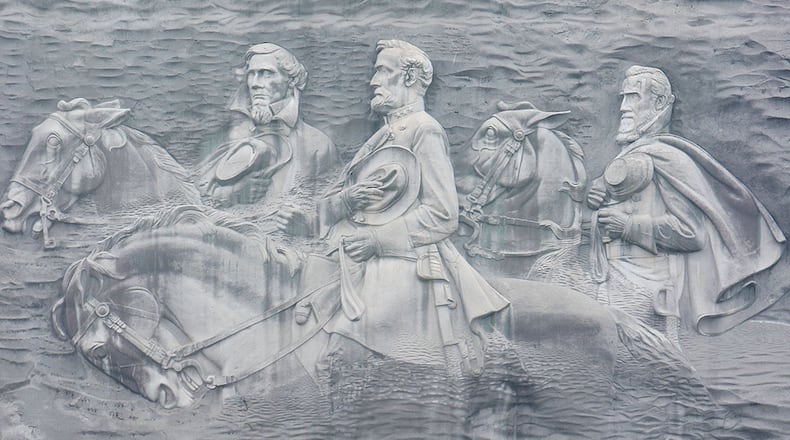From the archives: The story “A monument to granite determination” was originally published in the Atlanta Journal-Constitution on May 27, 1985.
JASPER - People moving into the Atlanta area from other sections of the country may not know the true story behind the memorial out at Stone Mountain.
The present-day Ku Klux Klan was born on top of that big rock. This is not worth mentioning, except for the fact that this is part of our history, although a shameful part.
On the mountain's north side, on a flat surface 800 feet high, an ambitious Confederate memorial was begun in 1912.
The idea was conceived by Mrs. Helen Plane, the widow of a Confederate officer and a member of the United Daughters of the Confederacy. Her idea went further than a bust of Lee. She asked Gutzon Borglum, the sculptor, to make the design. He, in turn, suggested, as a starter, five men on a horseback, each 150 feet high and each the figure of a Confederate leader.
A Stone Mountain "drive" was started and a committee was formed to raise funds. The Venable family, which owned the mountain, deeded the north side to this committee, known as an association.
The First World War came along and stopped the plans for the memorial. It was 11 years before the project could be revived. In 1923, a group of Atlanta businessmen took over. Money was subscribed with which to start.
Borglum came back to Atlanta. He made his working models and laid out the plans for the operation. Then on June 3, 1923, he drilled the first hole in the granite. The partially completed head of Lee was unveiled on the general's birthday, Jan. 19, 1924.
Rogers Winter, a young newspaperman, was put in charge of the memorial's publicity, and what a job he did! The Stone Mountain project became worldwide news. The whole country adopted the memorial as a national as well as sectional undertaking, and Congress officially adopted it. President Calvin Coolidge approved the minting of 5 million half-dollars with the sculptor's design on one side and the likenesses of Gens. Robert E. Lee and Stonewall Jackson on the other.
Credit: EDGAR ORR / SPECIAL TO AJC
Credit: EDGAR ORR / SPECIAL TO AJC
Borglum's contract with the group called for five figures for the first group for $250,000. The carvings were to be finished in three years, and the models were to be the property of the association.
As time slipped away, Borglum wasn't showing much progress. The group had advanced him the quarter of a million dollars. In February 1925, the group canceled its contract with him. Borglum destroyed the models in a rage and was indicted by a grand jury. He fled and was never arrested.
Augustus Lukeman was hired to finish the memorial. He scraped off Borglum's partially completed figures and did his own thing. His work, too, was slow, and Julian Harris, an Atlanta sculptor, took over in 1941 to finish the memorial.
Borglum, who had underestimated the job in the hard granite, went to Mount Rushmore, S.D., to do that memorial. He died before it was completed.
Now, anyone moving to Atlanta can know the story behind the Stone Mountain memorial. However, there is an interesting footnote: The Ku Klux Klan, which supported the memorial depicting Gen. Lee, may not have known that Lee was opposed to slavery, and, ironically, Union Gen. William T. Sherman supported it.
RELATED: Removing the rebels from Stone Mountain is not as easy as you might think
About the Author
Keep Reading
The Latest
Featured



